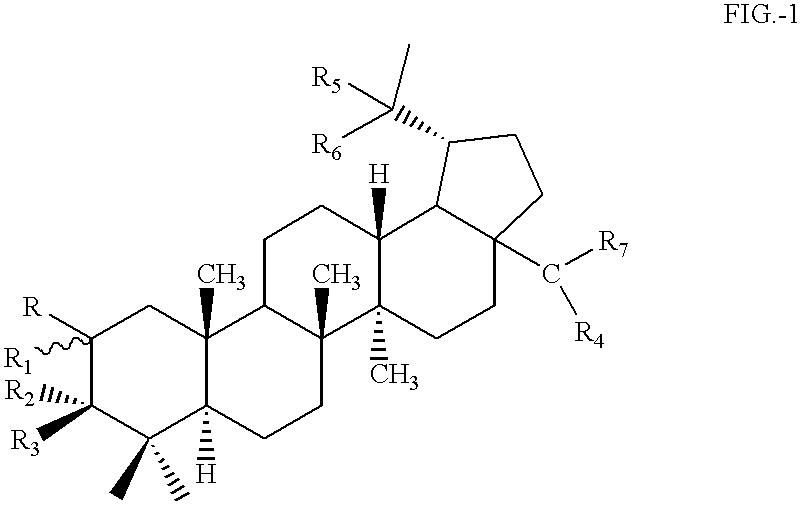Betulinic acid derivatives having antiangiogenic activity, processes for producing such derivatives and their use for treating tumor associated angiogenesis
a technology of betulinic acid and derivatives, which is applied in the direction of organic chemistry, amine active ingredients, organic active ingredients, etc., can solve the problems of betulinic acid and its derivatives interfering with selectin binding, and achieve the effect of low cost and high cost of synthetic antiangiogenic agents
- Summary
- Abstract
- Description
- Claims
- Application Information
AI Technical Summary
Benefits of technology
Problems solved by technology
Method used
Image
Examples
example 2
Preparation of 3-oxo-derivatives.
The substrate was dissolved in an organic solvent and conventional oxidizing agent was added under normal reaction conditions. The reaction was worked up as described in Method I to yield the corresponding 3-oxo derivatives in the pure form.
Example of oxidizing agents that can be vised are CrO.sub.3 / Py; CrO.sub.3 / H.sub.2 SO.sub.4 ; CrO.sub.3 / AcOH or the like. The normal reaction condition is stirring the substrate with oxidizing agent at from 0.degree. C. to room temperature for a few hours. The organic solvent may be selected from acetone CH.sub.2 Cl.sub.2, AcOH, mixtures thereof or the like.
example 3
Preparation of 2, 20,29-tribromo 3-oxo Derivative
A-3-oxo betulinic acid derivative prepared according to the process of Example 3 was dissolved in halogenated organic solvent. To this was added dropwise liquid bromine dissolved in the same solvent and the temperature was maintained between 0-10.degree. C. The reaction mixture was brought to room temperature and stirred for a few hours. The reaction was worked up as described in Method I of Example 2. The organic layer was washed with 5-10% aqueous alkaline solution and evaporated. The crystallized product yielded pure 2, 20, 29-tribromo-3-oxo derivatives. Examples of halogenated solvents that can be used are CCl.sub.4,CH.sub.2 Cl.sub.2, CHCl.sub.3 and the like; Examples of aqueous alkaline solution that can be used are bicarbonate or carbonate of an alkali metal in water, and the like.
3-Oxo-derivative of betulinic acid, dihydrobetulinic acid or their derivatives can be used in the processes of Examples 3, 4, 5, 8, 10 and 14.
example 4
Preparation of 3-oximino Derivative
A 3-oxo derivative is mixed in an alcoholic solvent such a methanol, ethanol, propanol and the like. To this was added alkyl hydroxylamine, phenyl hydroxylamine or benzyl hydroxylamine or its substituted derivatives and sodium acetate. The mixture was refluxed for a few hours. The reaction mixture was evaporated to dryness. The reaction was worked up as described in Method I of Example 2 and yielded crude-3-oximino derivative which crystallized to yield the corresponding pure 3-oximino derivative.
PUM
| Property | Measurement | Unit |
|---|---|---|
| temperature | aaaaa | aaaaa |
| temperature | aaaaa | aaaaa |
| temperature | aaaaa | aaaaa |
Abstract
Description
Claims
Application Information
 Login to View More
Login to View More - R&D
- Intellectual Property
- Life Sciences
- Materials
- Tech Scout
- Unparalleled Data Quality
- Higher Quality Content
- 60% Fewer Hallucinations
Browse by: Latest US Patents, China's latest patents, Technical Efficacy Thesaurus, Application Domain, Technology Topic, Popular Technical Reports.
© 2025 PatSnap. All rights reserved.Legal|Privacy policy|Modern Slavery Act Transparency Statement|Sitemap|About US| Contact US: help@patsnap.com



